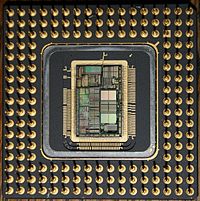Intel 80486
| << Intel 80486 >> | |
|---|---|
 486DX 33 MHz from Intel (open) |
|
| Production: | 1989 to 2007 |
| Producer: | Intel |
| Processor clock: | 16 MHz to 100 MHz |
| FSB cycle: | 16 MHz to 50 MHz |
| L1 cache size: | 8 KiB to 16 KiB |
| Manufacturing : | 1 µm to 0.6 µm |
| Instruction set : | x86 (16 bit) and x86-32 |
| Base: | |
Names of the processor cores:
|
|
80486 refers to the architecture of an x86 CPU, which was originally developed by Intel under the name i486 as a further development of its predecessor 80386 . Later, the 486 - as the 80486 is often called - was copied by many manufacturers: The AMD Am486 was a copy of the i486, while Cyrix (and thus IBM , TI and ST ) and UMC sold in-house developments.
The main architect was John Crawford .
Innovations
The most important difference compared to its predecessor was the 32-bit integer core, in which frequently used instructions were hard-coded and therefore microcode could be dispensed with for these commands . This enabled the CPU to execute a number of commands in just one cycle. So that the CPU is not completely slowed down by the memory interface (memory access takes 2 to 3 cycles even in the best case), it was necessary to integrate a first-level cache (L1 cache) with 1 cycle access time into the CPU.
In addition, there were fast burst modes to accelerate external access and some serious improvements in internal processing. The 80486 achieves on average more than twice the execution speed of an 80386 with the same clock frequency , whereby an adaptation of the program code is not necessary.
Most 80486 models also have an integrated math coprocessor , which speeds up floating point calculations considerably (models with or without a coprocessor can be identified by the suffix SX ). Since a math coprocessor was not yet a matter of course at the time, it was initially only supported by a few applications.
As a 32-bit processor, an 80486 processor can address a working memory of up to 4 GiB .
variants
The 80486 processor was offered in several variants with different performance. The entry-level model was the SX series, which, unlike the DX series, did not have an integrated floating point unit . Both model series were also available as a variant with double (SX2 or DX2), the DX as DX4 with triple internal clock frequency. The i486DX2 / 66 processor ran internally at 66 MHz, the front-side bus at 33 MHz.
The i486DX4 had a multiplier of 3 and achieved a CPU speed of 100 MHz with a bus speed of 33 MHz. It was also offered in a version for 25 MHz bus speed and 75 MHz CPU speed. The i486DX4 could only be used on particularly suitable mainboards or with an intermediate socket, since the CPU voltage was only 3.3 volts instead of the 5 volts that were usual up to that point.
The i486DX50 was one of the few processors for a 50 MHz bus. For certain requirements, e.g. B. at high data transfer rates, this variant was superior to an i486DX4, although the CPU itself also only ran at 50 MHz.
Models
Intel itself offered the processors under the name Intel i486 with various attached letters. The AMD Am486 was largely a copy of the Intel i486 and fully compatible with it.
The Cyrix Cx486 was an in-house development that was largely compatible with the Intel i486. This processor was also manufactured under license from IBM , SGS-Thomson and Texas Instruments .
The UMC Green CPU was developed, manufactured and sold by United Microelectronics Corporation . It was compatible with Intel's, but largely unknown.
swell
- ↑ Embedded Intel486 Processor Hardware Reference Manual, Intel, July 1997, Order Number 273025-001, chap. 2.1 "Processor Features"

